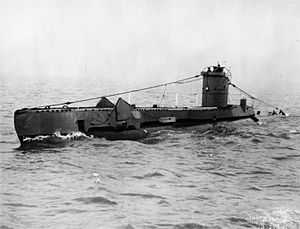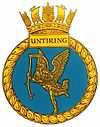HMS Untiring (P59)
 | |
| Career | |
|---|---|
| Class and type: | U-class submarine |
| Name: | HMS Untiring |
| Builder: | Vickers Armstrong, Newcastle upon Tyne |
| Laid down: | 23 December 1941 |
| Launched: | 20 January 1943 |
| Commissioned: | 9 June 1943 |
| Out of service: | Loaned to Greek Navy from July 1945 |
| Fate: | sunk as ASDIC target 25 July 1957 |
| Badge: |
 |
| Career | |
| Name: | Xifias II (Y-10) |
| In service: | July 1945 |
| Out of service: | Returned to Royal Navy in 1952 |
| General characteristics | |
| Displacement: | Surfaced - 540 tons standard, 630 tons full load
Submerged - 730 tons |
| Length: | 58.22 m (191 feet) |
| Beam: | 4.90 m (16 ft 1 in) |
| Draught: | 4.62 m (15 ft 2 in) |
| Propulsion: | 2 shaft diesel-electric 2 Paxman Ricardo diesel generators + electric motors |
| Speed: | 11.25 knots max surfaced
10 knots max submerged |
| Complement: | 27-31 |
| Armament: | 4 bow internal 21 inch torpedo tubes - 8 - 10 torpedoes
1 - 3 inch gun |
HMS Untiring (P59) was a Royal Navy U-class submarine built by Vickers-Armstrong. So far she has been the only ship of the Royal Navy to bear the name Untiring. After the war, she was loaned to the Greek Navy and renamed Xifias II (Y-10).
Wartime career
After a work up patrol off the Norwegian coast, where she sank the Norwegian fishing vessel Havbis II whilst she was fishing for halibut, Untiring was assigned to operate in the Mediterranean. Here, she went on to sink the German netlayer Netztender 44/Prudente, the German barge F 296, the German ships Jean Suzon/FP 352 and St. Antoine/FP 358, the German auxiliary minesweeper M 6022/Enseigne, the German merchants Diana and Siena (the former French Astrée), the German auxiliary submarine chasers UJ 6075 / Clairvoyant and UJ 6078/La Havraise, and also claimed to have sunk a sailing vessel with gunfire.
She also unsuccessfully attacked the German submarine U-616, the German auxiliary submarine chaser UJ 6073/Nimeth Allah, the German torpedo boat TA 18 (the former Italian Solferino), the German merchant Burgas and an unidentified German auxiliary patrol vessel.
Postwar
Untiring survived the war and was loaned to the Greek Navy in July 1946, where she was renamed Xifias. She served with the Greek Navy for seven years, and was returned to the Royal Navy in 1952. She was subsequently sunk as an ASDIC target on 25 July 1957. The wreck sits upright in 53 metres of water in an area of generally reasonable visibility and is easily reached from Salcombe or Plymouth. She is still in very good condition with little sign of collapse over the 46 years since she was sunk. The boat lists slightly to port and the propellers are still both visible above the loose gravel of the bottom. It is regularly dived by local and visitors. The boat has a good collection of growth on her and is home to numerous species of fish.
References
- Innes McCartney (2002). Lost Patrols: Submarine Wrecks of the English Channel.
- "HMS Untiring (P 59)". uboat.net.
- "Untiring to Urge". British submarines of World War II.
- Colledge, J. J.; Warlow, Ben (2006) [1969]. Ships of the Royal Navy: The Complete Record of all Fighting Ships of the Royal Navy (Rev. ed.). London: Chatham Publishing. ISBN 978-1-86176-281-8. OCLC 67375475.
- Hutchinson, Robert (2001). Jane's Submarines: War Beneath the Waves from 1776 to the Present Day. London: HarperCollins. ISBN 978-0-00-710558-8. OCLC 53783010.
| ||||||||||||||||||||||||||||||||||||||||||||||||||||||